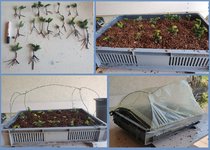Hi, im new here, but I’m following this forums Hemlock-threads for two years now. As I started interesting in bonsais 2 years ago I stumbled across this tree in a nursery und afterall what I knew at this time about bonsai it was i: Take this now or regret forever!
So after a lot searching the web and more researching I landed here and really THANK YOU all for your experience and advises for dealing with hemlocks (very underestimated here in Germany IMO).
Especially frozentreehugger and MrFancyplants: Thanks for sharing your knowledge and experience, I learned a lot from you, to keep my lady alive

As this is a study-thread here I finally can give something back, I hope.
Variant: Tsuga canadiensis “Vercade recurved”
- very slow growing( 10 years to 60cm)
- medium watering, but quite tolerant to “overwatering”
- halfshadow to full sun ( my is in full sun since 2 years)
- VERY ! brittle branches- danger of snowpressure breaking big parts off
- small recurved needles max. 5mm long
- frosthardiness -20 to -30 F / -28.9 to -34.4 C
- branches growing in every wiered and crossing directions,
- broad upright growth
- did I mention those absolute $%&ng brittle branches yet?!
- pestresilient (in Europe there is no adelgit, yet)
- til now only 2 backbudds, so keep inner growth wellwatched.
- very good healing over
- branches cracking if you only look at them, so keep away those fat sparrows and the neighbours cat
 View attachment 492385
Measures at this tree:
View attachment 492385
Measures at this tree:
- bought in August 21, acclimation to full sun
- slippotted October 21 in pond-basket (lead to really vigourous growth).
- mayor downsizing March 22
- trying to airlayer may 22 (-failed spring 23)
- cutting the rootball in half korizontally and putting in the pot: februar 23
- as it responded wery vell till now, downsizing furthermore june 23
- waiting for spring 24 for recovering and more reducing the right side and to get it more in a bonsai shape.
View attachment 492388
fresh from the nursery August 21
View attachment 492389
after cutting back even more today /June 23
- everything I cut of, I tried to make a cutting of. Nothing worked (aprox. 60 cuttings, various sizes, various soil) So last summer I finally found
this and build the nearing frame in the garden – filled with 90 pct vermiculite and 10 pct sphagnum moos in the middle and lower layers. Since 2 month there are now tiny buds. As it it so slow growing they will get out there next year.
- The nearing frame is my hot recommendation for difficult cuttings. It worked so well even for other nasty species! If someone is interested I can post some pics here as well.
Let’s see what the summer will bring us, and thanks a lot again.
Have fun growing with your trees

Tobi










